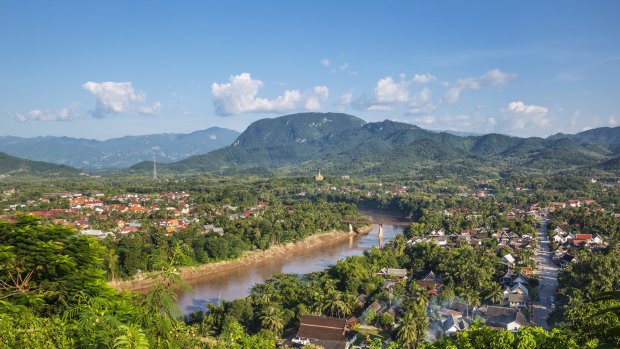This was published 9 years ago
Tombs of Laos: Why travellers are drawn to grave sites

Kerry van der Jagt journeyed into the forest around Luang Prabang and the Nam Khan River. Credit: Getty Images
The tomb sits in a clearing, covered in moss and lit by a single shaft of sunlight; it looks like the backdrop for an Indiana Jones movie. With only my guide for company I ascend the stone steps, unseen birds calling overhead as I kneel, to pay my respects and to read the plaque – Henri Mouhot 1826-1861.
Mouhot is known to the Western world as the French explorer who "rediscovered" Angkor Wat✓ in 1860. What isn't so known is that Mouhot was primarily a naturalist and that he died, aged just 35, on the banks of the Nam Khan River outside of Luang Prabang in Laos, after continuing his explorations along the Mekong.
"What did he die from?" I ask Kye, while slapping at a mosquito feasting on my bare shoulder. "Malaria," he says.
According to Kye, Mouhot died on this exact spot, taking his final breaths while still scribbling in his journal. "Have pity on me, O my God," were his final words penned on November 10, 1861.
His legacy is a detailed and unfinished diary of observations brought back to the French ambassador by his faithful servant Phrai.
"And even if destined here to meet my death, I would not change my lot for all the joys and pleasures of the civilised world," he wrote in travels to the central parts of Indo-China (Siam), Cambodia and Laos during the years 1858-60.
Even if destined here to meet my death, I would not change my lot for all the joys and pleasures of the civilised world.
Henri Mouhot
I have been fascinated with this stoic French explorer since first visiting Angkor Wat and reading his poetic observations on nature.
"Nature has her lovers, and those alone who have tasted them know the joys she gives," he wrote. After three trips to Laos and three failed attempts at finding Mouhot's grave site, I've finally found a guide that knows its secluded location.
It is late afternoon when Kye picks me up in his tuk-tuk for the 10-kilometre trip east of Luang Prabang to the village of Ban Phanom. I've been deserted by my travelling companions, who have decided an afternoon by the pool is more interesting than retracing a dead Frenchman's footsteps.
"We'll be in the bar when you get back," they tell me.
The track starts at a popular picnic spot but, Kye warns, this hike will be no picnic. It is the wet season and the Nam Khan is a swirling, twirling coffee-coloured mess. A torrential storm during the afternoon has left the air still and sticky and I can already feel the squelch of leeches inside my socks.
We cross a small timber bridge and are soon swallowed by the jungle. No one has travelled this way for months, and certainly not in the wet. With triffid-like tendrils clawing at our ankles, we follow a steep bank to the edge of the river. Ten minutes later we are upon it, a moss-covered shrine built against the hillside.
Constructed by the French in 1867, and replaced in 1887 by a more durable crypt, the raised white tomb marks the spot where Mouhot was buried. Neglected and consumed by the jungle, a bit like Angkor Wat itself, the tomb was accidentally rediscovered in 1990.
Standing alone in the jungle I wonder, and not for the first time, why travellers are drawn to visit such grave sites. From Oscar Wilde and Jim Morrison to Eva Peron and William Shakespeare, I've lined up to see them.
Is it out of curiosity, a desire to pay respects, or, are the graves a reflection of ourselves, and the secret fantasies we harbour about becoming explorers and writers, dreamers and schemers?
Placing my hand on the cool stone, I can almost see Mouhot's loyal servant Phrai collecting his master's journals and packaging them to take back to Siam. I can see the sketches and plant samples, reminding me of my own interest in botany, and his loose-leaf notes, the currency of any writer. This pilgrimage, like all the best travel experiences, is personal.
Back in Luang Prabang I meet up with my friends at Villa Maly, a French-Colonial boutique hotel with its Henri Mouhot bar. Barefoot, itchy and covered in mud I raise my glass to the portrait of the bearded man above the bar. He would approve of my drink of choice: gin with extra tonic.
TRIP NOTES
MORE INFORMATION
See tourismlaos.org
Australians need a visa to visit the Lao People's Democratic Republic, which can be obtained through Lao embassies, or a visa-on-arrival can be obtained at international checkpoints for $40, photo required. See laosembassy.net.
GETTING THERE
Thai Airways flies direct from Sydney and Melbourne to Bangkok daily. See www.thaiairways.com. Lao Airlines has daily connections from Bangkok to Luang Prabang. See laoairlines.com.
STAYING THERE
Villa Maly is a boutique hotel with deluxe rooms from $175 a night. The Henri Mouhot bar is the perfect spot for a gin and tonic. See villa-maly.com.
The writer travelled at her own expense.
Sign up for the Traveller Deals newsletter
Get exclusive travel deals delivered straight to your inbox. Sign up now.